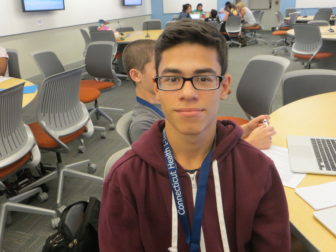African-American and Latino children are diagnosed with autism significantly later than their white counterparts, multiple studies show.

Christian Milian
A study that appeared in the Journal of Developmental and Behavioral Pediatrics in 2008 reports that white children who are on Medicaid on average tend to be diagnosed with an autism spectrum disorders (ASD) at 6.3 years of age. In comparison, African-American children are diagnosed at 7.9 years of age while Latinos are diagnosed at 8.8 years of age.
“Many people still need to learn the signs and act early,” said Melissa Olive, head of Applied Behavioral Strategies in Woodbridge.
Though signs of autism vary widely, parents should watch for difficulty with communication, difficulty with social interactions, obsessive interests and repetitive behaviors.
Since its start in 1993, the Birth to Three System has provided a way for parents and providers to intervene early with children who are eligible for services through a screening process. The screening is completed from the first 16 to 36 months of a child’s life.
Although these services are readily available, both providers and studies reveal racial disparities in when children are diagnosed. Without proper screening, which the Modified Checklist for Autism in Toddlers can help provide, children may not receive the services they need.
There are a number of reasons why a parent may not take a child to be assessed by a professional for possible ASD, said Eileen McMurrer, the Birth to Three Family and Community Support Team member.
These reasons include the literacy levels of parents, language barriers, fear of stigma and hesitation on having a child “labeled.”
“Children who receive a Birth to Three evaluation come from all races and many ethnicities,” said McMurrer, whose program serves over 4,000 children per year.
Some providers have found that screening is not happening during doctor visits.
“Screening should be happening at [primary care physicians], but I believe CCMC [Connecticut Children’s Medical Center in Hartford] has found that that rate is lower than was hoped,” said Alice Ridgway, assistant director of the Birth to Three program.
Experts say there should be programs for underserved groups, such as Latinos and African-Americans. Those groups face decreased access to services when compared to white children, according to data collected by the National Survey of Children’s Health in 2003 and 2004.
The U.S. Centers for Disease Control and Prevention estimates that 1 in 68 children have ASD nationally, and some government studies show rates as high as 1 in 45 children. CDC reports that “diagnosing autism spectrum disorders can be difficult since there is no medical test, such as a blood test, to assist in a diagnosis. Doctors often look at a child’s behavior and development to make a diagnosis.”
“Again, the white parents are going to press for screening/diagnosis,” Olive said. “Pediatricians receive zero training on recognizing autism in infants/toddlers.”
Christian Milan is a student at John F. Kennedy High School, Waterbury.